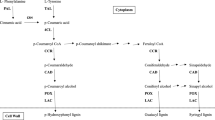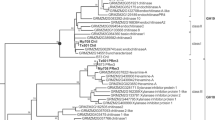Abstract
The fall armyworm,Spodoptera frugiperda (J. E. Smith), (FAW) is a major pest of corn,Zea mays L., in the southeastern United States. The damage to pretassel corn is caused by larvae feeding primarily on immature inner whorls. In this study, resistant lines were found to contain more crude fiber in whorls, mostly hemicellulose and cellulose. While hemicellulose, chiefly an arabinoxylan, was higher in resistant (R) lines than in susceptible (S) lines, the distribution of constituent neutral sugars was very similar in the lines. Both lines also containedp-coumaric and ferulic acids. These phenolic acids are known to occur both in the free state and in the cell wall as complexes bound by ester linkages to the arabinose moiety of the arabinoxylan.13C NMR data showed that the intensity of the carbonyl carbon (184 ppm) in resistant hemicellulose was stronger, indicating a greater degree of cross-linking. Thus, resistant hemicellulose is both structurally different from susceptible hemicellulose and present in greater quantities. In two of three laboratory dietary tests, FAW larval weight gains were significantly higher on diets with (S) hemicellulose incorporated at the same level as (R) hemicellulose. Therefore, resistance to the FAW appears to be correlated with both a greater amount and a higher degree of cross-linking of the hemicellulose of (R) lines.
Similar content being viewed by others
References
Bergvinson, D. J. 1993. Role of phenolic acids in maize resistance to the European corn borer,Ostrinia nubilalis (Hubner). PhD dissertation. University of Ottawa, Ottawa, Canada, 171 pp.
Bergvinson, D. J., Arnason, J. T., Hamilton, R. I., Tachibana, S., andTowers, G. H. N. 1994. Putative role of photodimerized phenolic acids in maize resistance toOstrinia nubilalis.Environ. Entomol. 23:1516–1523.
Buckley, P. M., Davis, F. M., andWilliams, W. P. 1991. Identifying resistance in corn to corn earworm (Lepidoptera: Noctuidae) using a laboratory bioassay.J. Agric. Entomol. 8:67–70.
Classen, D., Arnason, J. T., Serratos. J. A., Lambert, J. D. H., Nozzolillo, C., andPhilogene, B. J. R. 1990. Correlation of phenolic acid content of maize to resistance toSitophilus zeamais, the maize weevil in CIMMYT's collections.J. Chem. Ecol. 16:301–315.
Davis, F. M. 1989. Rearing southwestern corn borers and fall armyworms at Mississippi State, MS. pp. 27–36,in J. A. Mihm (ed.). Toward Insect Resistance Maize for the Third World. Proceedings, International Symposium on Methodologies for Developing Host Plant Resistance to Maize Insects. Centra Internacional de Mejoramiento de Maiz y Trigo, El Batan, Mexico.
Davis, F. M., Ng, S. S., andWilliams, W. P. 1988a. Mechanisms of resistance in corn to leaf feeding by southwestern com borer and European corn borer (Lepidoptera: Pyralidae).J. Econ. Entomol. 82:919–922.
Davis, F. M.,Williams, W. P.,Mihm, J. A.,Barry, B. D.,Overman, J. L.,Wiseman, B. R., andRiley, T. J. 1988b. Resistance to multiple lepidopterous species in tropical derived corn germplasm. Miss. Agric. For. Exp. Stn. Tech. Bull. 157, 6 pp.
Davis, F. M., Baker, G. T., andWilliams, W. P. 1995. Anatomical characteristics of maize resistant to leaf feeding by southwestern corn borer and fall armyworm.J. Agric. Entomol. 12:55–65.
Eraso, F., andHartley, R. D. 1990. Monomeric and dimeric phenolic constituents of plant cell walls—possible factors influencing wall biodegradability.J. Sci. Food Agric. 51:163–170.
Fry, S. C. 1986. Cross-linking of matrix polymers in the growing cell walls of angiosperms.Annu. Rev. Plant Physiol. 37:165–186.
Fry, S. C. 1989. Analysis of cross-links in the growing cell walls of higher plants, pp. 12–36,in H. F. Linskens and J. F. Jackson (eds.). Plant Fibers, Springer-Verlag, New York.
Guthrie, W. D., Wilson, R. L., Coats, J. R., Robbins, J. C., Tseng, C. T., Jarvis, J. L., andRussell, W. A. 1986. European corn borer (Lepidoptera: Pyralidae) leaf-feeding resistance and DIMBOA content in inbred lines of dent maize grown under field versus greenhouse conditions.J. Econ. Entomol. 79:1492–1496.
Hartley, R. D., andFord, C. W. 1989. Phenolic constituents of plant cell walls and wall biodegradability, pp. 137–145,in N. G. Lewis and M. G. Paice (eds.). Biogenesis and Biodegradation, ACS Symposium Series 399. American Chemical Society, Washington, D.C.
Hartley, R. D., andJones, E. C. 1978. Phenolic components and degradability of the cell walls of the brown midrib mutant, bm3, ofZea mays.J. Sci. Food Agric. 29:777–789.
Hartley, R. D., Whatley, F. R., andHarris, P. J. 1988. 4,4′-Dihydroxytruxillic acid as a component of cell walls ofLolium multiflorum.Phytochemistry 27:349–351.
Hedin, P. A., Davis, F. M., Williams, W. P., andSalin, M. L. 1984. Possible factors of leaf feeding resistance to corn in the southwestern corn borer.J. Agric. Food Chem. 32:262–267.
Hedin, P. A., Williams, W. P., Davis, F. M., andBuckley, P. M. 1990. Roles of amino acids, protein, and fiber in leaf feeding resistance of corn to the fall armyworm.J. Chem. Ecol. 16:1977–1995.
Hedin, P. A., Davis, F. M., andWilliams, W. P. 1993. 2-Hydroxy-4,7-dimethoxy-1,4-benzoxazin-3-one, a possible toxic factor in corn to the southwestern corn borer.J. Chem. Ecol. 19:531–542.
Hedin, P. A., Davis, F. M., Callahan, F. E., andDollar, D. A. 1994. Wheat germ hemicellulose is an absolute requirement for growth and development of the southwestern corn borer.J. Nutr. 124:2458–2465.
Helrich, K. (ed.). 1990. Methods of Analysis of the Association of Analytical Chemists, 15th ed., 1298 pp. Association of Official Analytical Chemists, Washington, DC.
Horwitz, W. (ed.). 1975. Methods of Analysis of the Association of Analytical Chemists, 12th ed., 1094 pp. Association of Official Analytical Chemists, Washington, DC.
Iiyama, D., Lam, T. B. T., andStone, B. A. 1990. Phenolic acid bridges between polysaccharides and lignin in wheat internodes.Phytochemistry 29:733–737.
Kato, Y., andNevins, D. J. 1985. Isolation and identification ofO-(5-O-feruloyl-α-l-arabinofuranosyl)-(1 → 3)-O-β-d-xylopyranoxyl-(1 → 4)-d-xylopyranose as a component ofzea shoot cell walls.Carbohydr. Res. 137:139–150.
Klun, J. A., andBrindley, T. A. 1966. Role of 6-methoxybenzoxazolinone in inbred resistance of host plant (maize) to first brood larvae of European corn borer.J. Econ. Entomol. 59:711–718.
Lyons, P. C., Hipskind, J., Vincent, J. R., andNicholson, R. L. 1993. Phenylpropanoid dissemination in maize resistant or susceptible toHelminthosporium maydis.Maydica 38:175–181.
Morrison, I. M. 1979. Carbohydrate chemistry and rumen digestion.Proc. Nutr. Soc. 38:259–274.
Morrison, I. M., Robertson, G. W., Stewart, D., andWightman, F. 1991. Determination and characterization of naturally occurring phenolic acids.Phytochemistry 30:2007–2011.
Ritchie, S. W., andHanway, J. J. 1982. How a corn plant develops. J. Iowa State Univ. of Sci. and Tech. Coop. Ext. Serv. Special Rpt. 48, 21 pp.
Selvendran, R. R. andRyden, P. 1990. Isolation and analysis of plant cell walls, pp. 549–579,in P. M. Dey and J. B. Harborne (eds.). Methods in Plant Biochemistry, Vol. 2, Carbohydrates. Academic Press, San Diego, California.
Sosulski, R., Krygier, K., andHogge, L. 1982. Esterified and insoluble-bound phenolic acids. 3. Composition of phenolic acids in cereal and potato flours.J. Agric. Food Chem. 30:337–340.
Sturgeon, R. J. 1990. Monosaccharides, pp. 1–37,in P. M. Dey and J. B. Harborne (eds.). Methods in Plant Biochemistry, Vol. 2, Carbohydrates. Academic Press, San Diego, California.
Van Soest, P. J., andWine, R. H. 1967. Method for the determination of plant cell walls.J. Assoc. Off. Anal. Chem. 50:50–51.
Waiss, A. C., Jr., Chan, B. G., Elliger, C. A., Wiseman, B. R., McMillan, W. W., Widstrom, N. W., Zuber, M. S., andKeaster, A. J. 1979. Maysin, a flavone glycoside from corn silks with antibiotic activity.J. Econ. Entomol. 72:256–258.
Williams, W. P. andBuckley, P. M. 1992. Growth of fall armyworm (Lepidoptera: Noetuidae) larvae on resistant and susceptible corn.J. Econ. Entomol. 85:2039–2042.
Williams, W. P., andDavis, F. M. 1995. Mechanisms and bases of resistance in maize to southwestern corn borer and fall armyworm. Proceedings, International Symposium on Methodologies for Developing Host Plant Resistance to Maize Insects. Centro Internacional de Mejoramiento de Maize Y Trigo, El Batan. Mexico. In press.
Williams, W. P., Buckley, P. M., andDavis, F. M. 1985. Larval growth and behavior of the fall armyworm (Lepidoptera: Noetuidae) on callus initiated from susceptible and resistant corn hybrids.J. Econ. Entomol. 78:951–954.
Williams, W. P., Buckley, P. M., andDavis, F. M. 1987. Tissue culture and its use in investigations and insect resistance of maize.Agric. Ecosyst. Environ. 18:185–190.
Williams, W. P., Buckley, P. M., Hedin, P. A., andDavis, F. M. 1990. Laboratory bioassay for resistance in corn to fall armyworm (Lepidoptera: Noctuidae) and southwestern corn borer (Lepidoptera: Pyralidae).J. Econ. Entomol. 83:1578–1581.
Williams, W. P., Buckley, P. M., andDavis, F. M. 1995. Combining ability in maize for fall armyworm and southwestern corn borer resistance based on a laboratory bioassay for larval growth.Theor. Appl. Genet. 90:275–278.
Wiseman, B. R., Williams, W. P., andDavis, F. M. 1981. Fall armyworm resistance mechanisms in selected corns.J. Econ. Entomol. 74:622–624.
Wiseman, B. R., Davis, F. M., andWilliams, W. P. 1983. Fall armyworm: Larval density and movement as an indication of nonpreference in resistant corn.Protect. Ecol. 5:135–141.
Yang, G., Isenhour, D. J., andEspelie, K. E. 1991. Activity of naize leaf cuticular lipids in maize resistance to leaf-feeding by the fall armyworm.Fla. Entomol. 74:229–236.
Yang, G., Wiseman, B. R., andEspelie, K. E. 1992. Cuticular lipids from silks of seven corn genotypes and their effect on development of corn earworm larvae [Helicoverpa zea (Boddie)].J. Agric. Food Chem. 40:1058–1061.
Author information
Authors and Affiliations
Additional information
Mention of a trademark, proprietary product, or vendor does not constitute a guarantee of warranty of the product by the U.S. Department of Agriculture and does not imply its approval to the exclusion of other products or vendors that may also be suitable.
Rights and permissions
About this article
Cite this article
Hedin, P.A., Davis, F.M., Williams, W.P. et al. Hemicellulose is an important leaf-feeding resistance factor in corn to the fall armyworm. J Chem Ecol 22, 1655–1668 (1996). https://doi.org/10.1007/BF02272405
Received:
Accepted:
Issue Date:
DOI: https://doi.org/10.1007/BF02272405




